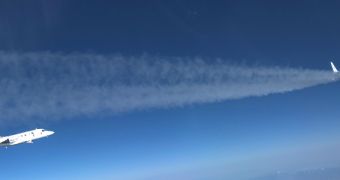Officials with the American space agency announce that NASA has partnered up with the German Aerospace Center (DLR) and the National Research Council of Canada (NRC) for a series of studies concerning the atmospheric effects of burning alternative fuels to power up jet engines.
This type of studies is very important as the world starts contemplating the switch from conventional to alternative fuel sources, including for military applications. The US Air Force (USAF), like all other air forces around the world, is not opposed to making this change in principle, but it does not want to experience any diminished capabilities either.
The main concern with alternative fuels is that they may decrease the efficiency of jet engines and therefore make aircraft more susceptible to being taken down by the enemy. The research NASA has just signed into via two separate agreements seeks to determine how jet engines fare with the new fuels and also to assess how chemicals produced in this manner affect the atmosphere.
All science flights will be carried out under the Alternative Fuel Effects on Contrails and Cruise Emissions (ACCESS II) program, which is scheduled to commence on May 7. The flights will be conducted from the newly-renamed NASA Armstrong Flight Research Center (AFRC) at the USAF Edwards Air Force Base (EAFB), in California.
Each organization will contribute its own aircraft to this study. NASA will be using its DC-8 and HU-25C Guardian airplanes, DLR will be bringing the Falcon 20-E5, and NRC its CT-133 research aircraft. The engines on the DC-8 will be powered by various fuel mixtures, while the Falcon and CT-133 aircraft will fly behind it, assessing emission and revealing contrail formation patterns in real-time.
“Partnering with our German and Canadian colleagues allows us to combine our expertise and resources as we work together to solve the challenges common to the global aviation community such as understanding emission characteristics from the use of alternative fuels which presents a great potential for significant reductions in harmful emissions,” explains NASA official Jaiwon Shin.
The expert holds an appointment as the associate administrator for aeronautics research at NASA Headquarters, in Washington DC. ACCESS II follows in the footsteps of ACCESS I, which was conducted in 2013 and demonstrated that black carbon, organic molecules, and sulfates emissions can all be reduced by burning biofuel blends in jet engines.
“Cooperation between DLR and NASA is based on a strong mutual appreciation of our research work. We are very pleased to be performing joint test flights for the first time, and thus set an example by addressing pressing research questions in global aviation together,” comments the Executive Board member at DLR in charge of aeronautics research, Rolf Henke.

 14 DAY TRIAL //
14 DAY TRIAL //